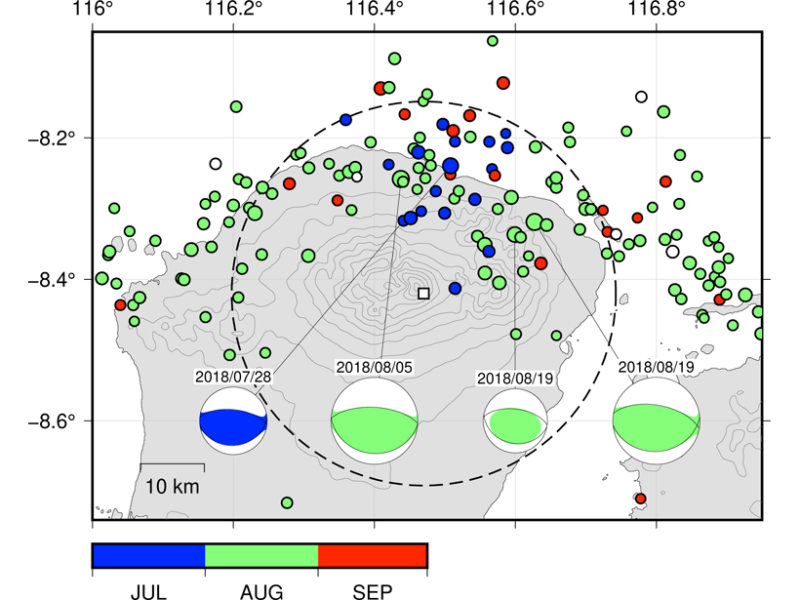4.7.21
Ilya Zaliapin
A global study suggests that volcanic eruption forecasting and detection may be improved by examining earthquake mechanisms and clustering in combination with individual volcano properties.

Seismicity near Mount Rinjani volcano (white square) at Lombok Island, Indonesia, during July-September 2018, according to the USGS ComCat catalog. Colors represent event timing as indicated in the legend. Moment tensors (beachballs) are shown for the four earthquakes with magnitude above M6. Dashed circle shows the 30 km radius used to associate earthquakes with volcanoes in the study. Currently, over 1 million people live within this circle. The lack of similar historical seismicity in the area, the swarm-like nature of the earthquakes, and a substantial percentage of the non-double-couple components raise concerns that the volcano may be awakening. Credit: Pesicek et al. [2021], Figure 10.
Earthquakes are known to precede and coincide with volcanic activity, being triggered by multiple mechanisms (such as stress and pore pressure changes) related to the magmatic processes. Thus it might be possible to use seismicity to forecast impending volcanic eruptions and detect ongoing eruptions at remote and submarine locations that may lack permanent close monitoring.
Pesicek et al. [2021] offer a global quantitative perspective on the problem. They examine 870 volcanoes with confirmed Holocene eruptions (those that happened within the past 11,700 years) in relation to the earthquakes with magnitude equal to or above 4 within 30 kilometers of the vent. The occurrence of such an earthquake by itself does not tell much (only 1 percent of events are followed by an eruption and only 11 percent of eruptions are preceded by earthquakes), but additional properties of volcanos and seismicity may have improved predictive power. In particular, more than half of the examined multiple-event swarms with an increased percentage of non-double-couple earthquake mechanisms preceded eruptions.
The results suggest that combining individual volcano properties and multiple earthquake statistics may inform and improve multi-disciplinary approaches to probabilistic volcano forecast and detection.
Science paper:
Journal of Geophysical Research: Solid Earth
See the full article here .
five-ways-keep-your-child-safe-school-shootings
Please help promote STEM in your local schools.
Eos is the leading source for trustworthy news and perspectives about the Earth and space sciences and their impact. Its namesake is Eos, the Greek goddess of the dawn, who represents the light shed on understanding our planet and its environment in space by the Earth and space sciences.

